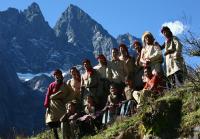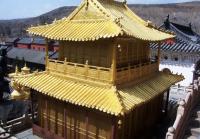Blang Ethnic Group
The Blang people are one of the 56 ethnic groups officially recognized by the People's Republic of China. The Blang nationality is an ancient indigenous people with a long history in southwest China. According to historical records, an ancient tribe which called the "Pu" was the earliest inhabitants of the Lancang and Nujiang river valleys. These people may have been the ancestors of today's Blangs.
Population
119,639 (2010)
Main Areas Inhabited by Blang
The Blang people, numbering 119,639, live mainly in Mt. Blang, Xiding and Bada areas of Menghai County in the Xishuangbanna Dai Autonomous Prefecture in southwestern Yunnan Province. There are also scattered Blang communities in the neighboring Lincang and Simao prefectures. All the Blangs inhabit mountainous areas 1,500-2,000 meters above sea level. The Blangs in Xishuangbanna have always lived harmoniously with their neighbors of both the other minority nationalities and the majority Han.
Climate and Resources
The Blang people inhabit an area with a warm climate, plentiful rainfall, fertile soil and rich natural resources. The main cash crops are cotton, sugar-cane and the world famous Pu'er tea. In the dense virgin forests grow various valuable trees, and valued medicinal herbs such as pseudoginseng, rauwolfia verticillata (used for lowering high blood pressure) and lemongrass, from which a high-grade fragrance can be extracted. The area abounds in copper, iron, sulfur and rock crystal.
History
Chinese ethnographers identify the Blang as descendants of an ancient tribe known as the "Pu", who lived in the Lancang river valley during ancient times. It is believed that these people were one branch of a number of peoples that were collectively known to the ancient Chinese as the Bǎipú.
Language
The Blangs speak a language belonging to the South Asian language family. The language does not have a written form, but Blangs often know the Dai, Va and Han languages.
Religion
Before China’s national liberation, the Blang people were very superstitious. Ancestor worship was a part of their way of life. The Blangs in Xishuangbanna area believed in Hinayana Buddhism, as a result of the influence of the Dai tribe. The Blangs' Buddhist temples and social systems were similar to those of the Dais.
Clothing
Blang men wear collarless jackets with buttons down the front and loose black trousers. They wear turbans of black or white cloth. Men have the tradition of tattooing their limbs, chests and bellies. Blang women, like their Dai sisters, wear tight collarless jackets and tight striped or black skirts. They tie their hair into a bun and cover it with layers of cloth.
Food
Their staple diet consists of rice, maize and beans. They prefer their food sour and hot. Drinking home-brewed wine and smoking tobacco are their main pastimes. Blang women like chewing betel nut and regard teeth dyed black with betel-nut juice as beautiful.
Building
The Blangs live in two-storied balustraded bamboo houses. The ground floor is for keeping domestic animals and storing stone mortars used for hulling rice. The upper floor is the living quarters, and in the middle of the main room is a fireplace for cooking, heating and light. When a family builds a house, nearly all the grown-ups in the village offer help, completing the project in two or three days.
Culture and Art
The Blang ethnic group has a rich store of folk tales and ballads transmitted orally. Their songs and dances show the strong influence of their Dai neighbors. Elephant-leg drums, cymbals and three-stringed plucked instruments provide musical accompaniment for dancing. People in the area of Blang Mountain are revel in their energetic "knife dance." Young people like a courting dance called the "circle dance." For the Blangs in the Mujiang area, New Year's Day and weddings are occasions for dancing and singing, often lasting the whole night.
Marriage
The Blangs seek spouses outside their own clans and practice monogamy. With a few exceptions, mainly parental interference, young Blangs are fairly free to choose marriage partners.
Obsequies
The death of a person is followed by scripture chanting by Buddhist monks or shamans to "dispel the devil," and the funeral is held within three days. Each village generally has a common cemetery divided according to clans or people having the same surnames. The dead are buried in the ground except for those dying a violent, who is cremated.
Past Social Conditions
Before liberation in 1950, social development was uneven in different Blang localities. The Blang communities in the Lincang and Simao prefectures were fairly developed socially and economically, as their members lived together with Hans and other more socially advanced peoples. Except for cemeteries and forests, which remained common property, land had become privately owned. A landlord economy had long been established, with landlords and rich peasants taking possession of the best land through exorbitant interest rates, mortgages, pawning and political privileges. Poor Blang peasants, aside from being at the mercy of landlords and rich peasants of Blang origins, were exploited by propertied classes of Han and other ethnic minorities. The Bao-Jia system (an administrative system organized on the basis of households, instituted by the Kuomintang government in 1932) tightened political control over all the Blang areas. The Kuomintang government, in collaboration with local landlords and tyrants, caused great suffering to the Blang people by excessive levying of taxes and forced conscription.
The Blang communities in Xishuangbanna's Mt. Blang, Xiding and Bada areas were less socially developed and more poverty-stricken. The Blangs had long been subjected to the rule of Dai feudal lords, who exacted from them an annual tribute of money and farm produce. The Dai landlords appointed a number of hereditary headmen called "Ba" from among the Blangs. Each "Ba" had several Blang villages under his rule and collected tributes for the Dai masters.
Blang society in Xishuangbanna retained varying degrees of public ownership of land by the clan or the village, aside from private ownership. A small number of villages had retained characteristics of the primitive commune, which was composed of 20-30 small families who had a common ancestor. Commune farmland, forests and pastures belonged to all the members. Families and individuals had the right to utilize this kind of land, but could not buy or sell it. As productivity developed, however, the patriarchs took advantage of their positions to gradually grab property for themselves, and began to exploit clan members.
Most Blang villages in Xishuangbanna had primitive commune features. Each village consisted of some 100 households belonging to several or a dozen clans of different blood relationships. While farm implements, houses and farm animals belonged to individual households, land, forests and water sources were the village's common property. The different clans took permanent possession of different parts of the public land and allocated their share to small families under them on a regular basis to enable farming on a household basis. The households were entitled to the harvest. Just as each small family depended on its clan membership for the use of land, each clan relied on its affiliation to the village for its right to use the village land. Once a clan moved elsewhere, its land reverted to the village. When a newcomer applied for land, a meeting of headmen would decide how much to allocate.
Members of a village commune were engaged in the same kind of political and religious activities. Public officials of the commune, namely the headmen, were elected.
Gradually, however, private ownership of land emerged. Many village commune members lost their land, becoming tenants of headmen or rich households. Their land henceforth assumed a completely private nature: it could be sold or bought, mortgaged or rented. Patriarchs or the elected headman of a village commune, taking advantage of their position, often took permanent possession of large amounts of good land.
Production was at an extremely low level before liberation in Xishuangbanna's Blang area. Agriculture was the economic mainstay of Blang society, with dry rice as the dominant crop, followed by tea and cotton. At the beginning of the spring ploughing season, patriarchs would organize clan members to clear forest land and allocate it among individual households for farming. Harvests were poor. The Blangs' low income contrasted sharply with their heavy economic burden, which included tribute, high interest to money lenders, different kinds of taxes and corvee.
Post-liberation Life
In the spring of 1950, the Chinese People's Liberation Army entered the Blang area. By driving out bandits and local tyrants, and taking measures to protect the lives and property of the people of different nationalities, the army soon stabilized social order in this frontier region. This was followed by the people's government sending work teams to help the Blangs develop production and establish grassroots organs of power. Blangs sent their representatives to the prefectural and county people's congresses, where they exercised their rights as masters of their own affairs.
In light of the actual conditions in the Blang area, the government conducted a series of social reforms aimed at gradually eliminating feudal exploitation and vestiges of primitive backwardness hampering social development. Between 1952 and 1953, a land reform similar to that in the Han areas was carried out in Zhenkang, Lincang, Yanxian, Jingdong, Jinggu, Mujiang and other areas. In 1955-56, land reform of a more moderate nature was conducted in Gengma, Shuangjiang and some parts of Lancang, followed by the setting up of production cooperatives. In Xishuangbanna and Lancang's Nuofu area, where vestiges of primitive communism still existed, social reform progressed more slowly. It was not until 1958 that some cooperatives were set up there on a trial basis.
Since 1949, with the help of their Han and Dai neighbors, but mainly relying on themselves, the Blang people have made much progress in adopting more advanced farming methods. They have created paddy fields, built water-conservancy projects, begun using fertilizers and advanced farming tools, and adopted efficient management methods. As a result, the grain harvest has kept going up every year, as has the production of tea and cotton.
Commerce, education and health care have also developed rapidly. An ethnic minorities trading corporation has been set up in every prefecture; in some villages there are shops with a fairly complete stock of farm tools and daily-use items. State trading organizations purchase local produce in large quantities, resulting in increased income for the Blang people.
There were almost no schools in the Blang areas before 1949. In some places, young men were able to learn a little of the Dai language through chanting Dai Buddhist scriptures as trainee monks. Now all Blang children attend primary schools, which are evenly distributed in Blang villages.
The absence of any medical facilities in the Blang area before 1949 used to compel sick people to seek help from shamans and other charlatans. In the early post-1949 days, the government sent medical teams to the area, providing free medical care. Later, clinics were set up, local medical teams formed, and medical workers of Blang origin trained. Epidemics such as dysentery, smallpox and malaria were basically brought under control. As a result, the general health conditions of the Blang people have greatly improved.
Festivals
Most traditional festivals of the Blang nationality are related to religious activities, the most characteristics festivals among them are Guonian Festival and Close the Door Festival, etc.
Taboos
Walking across the fireplace is forbidden; taking prey back home is not allowed when the family has a pregnant woman.
Recommended China Tour Packages
-
10-day Yunnan-China Tea Horse Road Tour
-
11-day China Ice Festival Culture Tour
-
15-day Ancient Chinese Secrets

















